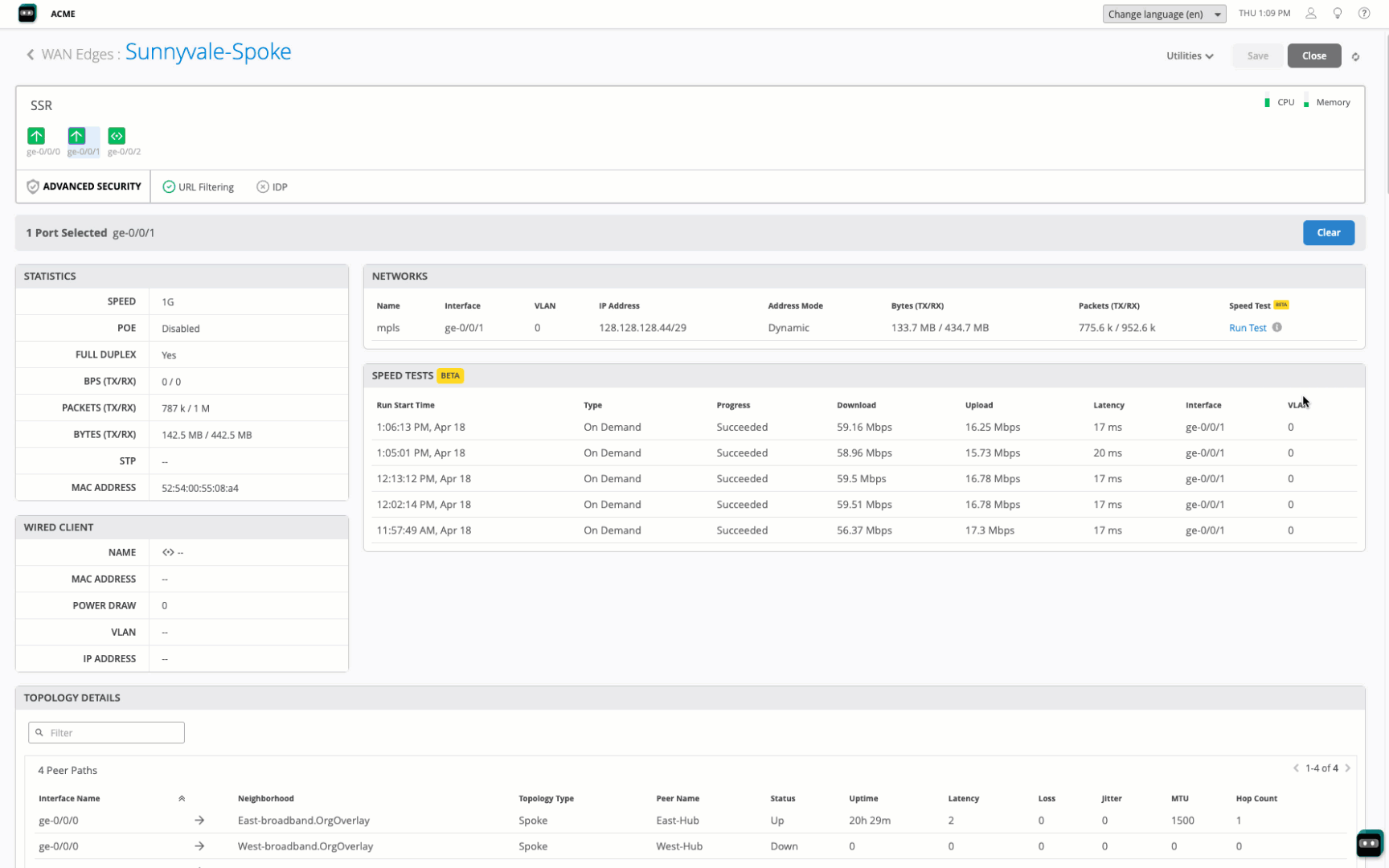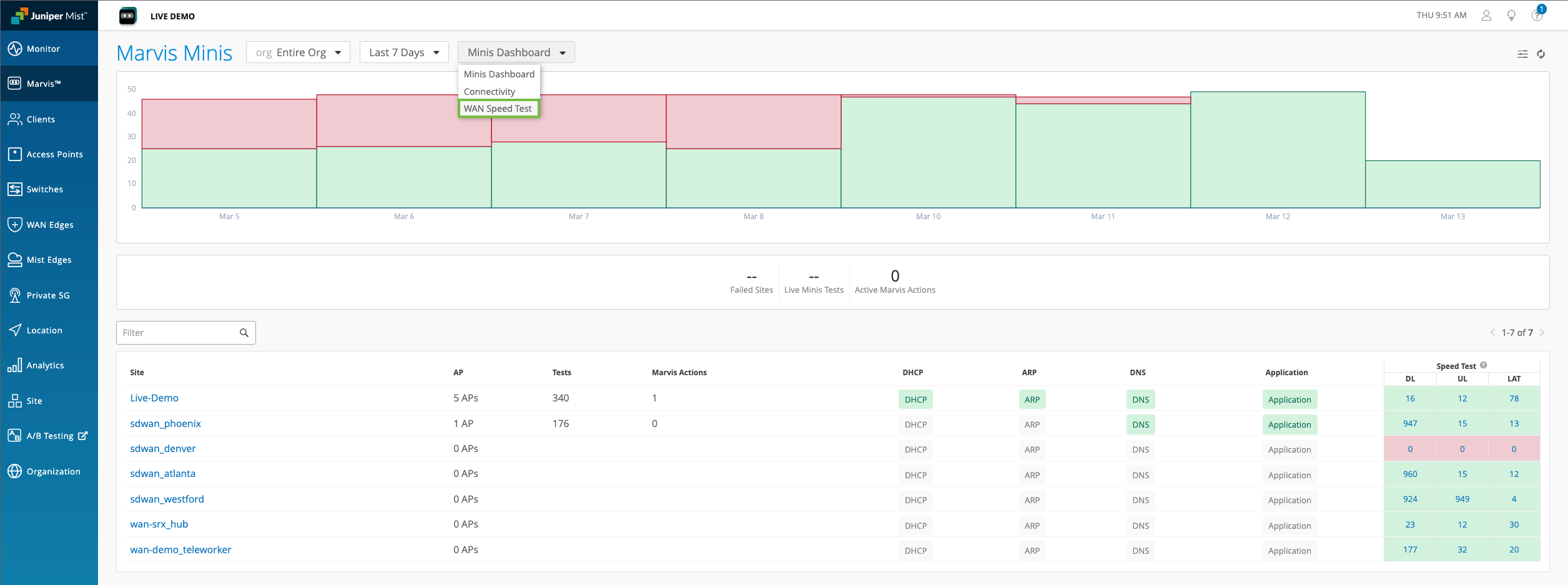Speed Tests for WAN Edge Devices
Follow these steps to do speed edge tests on your WAN Edge devices.
Service Providers (SPs) as well as their end customers install and deploy telecommunication circuits (or paths) to offices, branches, and so on. As Session Smart Routers or SRX Series Firewalls are deployed at the edge of the customer premise, SPs and customers need to generate traffic to test the speed and performance of these circuits to ensure the quality is being maintained.
You can test the speed of WAN links on WAN Edge devices to ensure optimal performance. This feature allows for new link qualification and on-demand speed tests if a low link speed is suspected.
From the Juniper Mist™ portal, you can use a speed test to:
- Test the speed and performance of the circuit being delivered to the customer.
- Perform new link qualification to verify that speeds are what the service provider and customer have agreed upon.
- Perform on-demand speed tests when you suspect a low link speed is causing link issues.
- Run scheduled speed tests to re-test link speeds and ensure performance continues to meet expectations on an ongoing basis.
The WAN Edge Speed Test tool can reliably validate circuits speeds of 1 megabit per second (Mbps) to 1 gigabit per second (Gbps). Circuits exceeding 1Gbps must rely on other tools for validation.
The WAN Edge Speed Test tool does not measure or validate jitter or loss.
Perform Speed Test on WAN Edge Device
Use the following steps to perform the on-demand Speed Test:
- Navigate to the Juniper Mist portal, then click WAN Edges > WAN Edges.
- Select the WAN Edge name.

- Select the WAN port from the Port Panel.

- The Networks section then appears. From the Networks section, under the Speed Test column, click Run Speed Test.
- In the Speed Tests section, the test you are currently running is In Progress.
After a minute or two, the progress of the speed test changes to Succeeded, and the
results populate in the columns, displaying information such as download speed, upload
speed, latency, the interface the test was run on, and the VLAN number.

Schedule a Speed Test
If you need to run speed tests on a recurring basis, you can use the WAN Speed Test Scheduler.
- Navigate to Organization > Admin > Settings.
- In the WAN Speed Test Scheduler section, select Enabled.
Uncheck the Enable Automatic Speed Test checkbox.
- Select the Time of Day and Day of Week that you want the speed tests to occur.
- Select whether you want to run the tests on all WAN interfaces or select WAN interfaces.

- Save your settings.
Enable Automatic Speed Tests (BETA)
To have Marvis automatically run self-driving speed tests on selected WAN interfaces during times of low activity, you can enable automatic WAN speed tests. You can configure this in the WAN interface configuration at the WAN Edge template-level or the device-level. For Ethernet interfaces, the Enable Scheduled Speed Test checkbox is selected by default. The checkbox applies to both automatic and scheduled speed tests.
- Navigate to Organization > Admin > Settings.
- In the WAN Speed Test Scheduler section, select Enabled.
Select the Enable Automatic Speed Test checkbox.

Now enable automatic speed tests at the WAN Edge template-level by navigating to Organization > WAN > WAN Edge Templates and select the template, or at the WAN Edge device-level by navigating to WAN Edges > WAN Edges, and then select the device.
Scroll down to the WAN section, then select the appropriate WAN interface.
Select or deselect the Enable Scheduled Speed Test checkbox as needed for the necessary interfaces.
 Note: For Ethernet interfaces, the Enable Scheduled Speed Tests checkbox is selected by default. For devices with built-in LTE interfaces, the checkbox is unchecked by default. Automatic speed tests for LTE devices are not enabled by default , as it can result in costliness if you pay for bandwidth usage through a service provider. However, if you have LTE interfaces connected to your Ethernet interfaces, such as on your Cradlepoint devices, you must deselect the checkbox from the Ethernet interface configuration.
Note: For Ethernet interfaces, the Enable Scheduled Speed Tests checkbox is selected by default. For devices with built-in LTE interfaces, the checkbox is unchecked by default. Automatic speed tests for LTE devices are not enabled by default , as it can result in costliness if you pay for bandwidth usage through a service provider. However, if you have LTE interfaces connected to your Ethernet interfaces, such as on your Cradlepoint devices, you must deselect the checkbox from the Ethernet interface configuration.- Save your settings.
You can view the Speed Test results from the WAN Edge page or by navigating to Marvis > Marvis Minis, then select WAN Speed Test from the drop-down menu at the top of the page. You will then see a list of completed speed tests per site and device along with the results.

Review Speed Tests in Marvis Minis
The Marvis Minis dashboard provides visibility into the validation results. You can schedule speed test and view the results in Marvis Minis. This proactive approach helps in identifying and resolving network issues before they affect users.
To view the speed test results in Marvis Minis, you must:
- Schedule the Speed Test
- Enable Marvis Minis at the organization level (Organization> Settings) or at site level (Organization > Site Configuration).
To view the Marvis Minis dashboard, select Marvis > Marvis Minis from the left menu.
In the Marvis Minis page, you’ll see the major elements of the dashboard including the summary of speed test.
- At the top of the page, use filters to select WAN Speed Test from
the drop-down box. You can also select to display results at organization-level or at
site-level and set the time period for the results. Figure 1: Marvis Minis Dashboard

- You can view the details of speed test results. Results populate in the columns,
displaying information such as site, device, interface, download speed, upload speed,
latency, type, result of the test, and start time of the test. Figure 2: Marvis Minis WAN Test Speed Results

- You can click a site to display the test results at that site-level.
